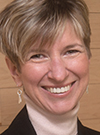Year of the Humanities Profile: The Art of Engineering
As a high school student in Illinois, Mary Besterfield excelled in math and science, but she also had artistic talent. The aspiring artist told her parents she wanted to attend art school. Her father, an engineering professor at Southern Illinois University Carbondale, was a practical man, so he struck a deal with his daughter. If she got her engineering degree first, then he would pay for art school, too.
 So off she went to engineering school at the University of Missouri-Rolla. When she graduated with a bachelor’s of science degree in engineering management in 1986, her father told her he would make good on his art school promise. But the study of engineering had changed the aspiring artist’s plans. Instead, she went on to earn a master’s degree in industrial engineering from Purdue University and then a PhD in industrial engineering from the University of Pittsburgh.
So off she went to engineering school at the University of Missouri-Rolla. When she graduated with a bachelor’s of science degree in engineering management in 1986, her father told her he would make good on his art school promise. But the study of engineering had changed the aspiring artist’s plans. Instead, she went on to earn a master’s degree in industrial engineering from Purdue University and then a PhD in industrial engineering from the University of Pittsburgh.
Though she no longer dabbles in art, Besterfield-Sacre (her married name) still appreciates the arts, and sees a strong overlap between engineering and the humanities.
“The purpose of engineering is to make humankind better,” says Besterfield-Sacre, a Fulton C. Noss Faculty Fellow and an associate professor of engineering at Pitt.
As Pitt celebrates this year’s Year of the Humanities in the University, it’s useful to see how people from diverse fields draw from the humanities in their work.
Besterfield-Sacre serves on the steering committee for this year’s celebration of the humanities. Joining her are faculty in fields ranging from pharmacy, law, business, engineering, physics, and political science, as well as colleagues from English literature, music, and other humanities departments.
As director of the Engineering Education Research Center at the Swanson School of Engineering, Besterfield-Sacre conducts engineering education research. She says a humanities slant is crucial to educating creative engineers. “We need to have a sense of relevance that will help with the motivation of study.”
She also teaches the capstone undergraduate course in industrial engineering, in which students use their engineering skills to do projects in the community, including one at Jeremiah’s Place, a crisis nursery for children in the community. Engineering students helped the nonprofit group by developing a database to replace the paper-intake system and by starting an inventory management system.
Besterfield-Sacre is also part of a group of faculty vested in increasing innovation and entrepreneurship in the school of engineering. For example, the Swanson School of Engineering offers a class called “The Art of Making,” a hands-on system design and engineering class that fosters creativity and problem-solving. Freshman engineering honor students and upper-classmen work in groups to solve problems and build everything from a mechanical hand to a motorized vehicle.
Such creative exercises, she says, force engineers to look broadly at the problem. “Instead of starting at step one, they have to take a step back to zero to figure out what the problem is.”
The Swanson School program also instills a global awareness and social consciousness in students, and has several electives that give students the opportunity to travel abroad. In the fall and spring semesters, a group of engineering students travels to Panama to work with an indigenous community to build water and sewage systems.
In a class called “Engineering of the Renaissance,” two engineering faculty members take a group of about 20 to 25 students to Florence in May to study the connections between art, architecture, and engineering.
“Engineering is hard. Students can get wrapped up in the technical and science aspects,” she says. “But we want to make sure they understand that engineering is part of society.”
The school also explores the link between math and music ability, a connection suggested by the fact that one-third of Pitt’s marching band are engineering students. The school offers a one-credit “Music Engineering” course, complete with a music studio (the Music Engineering Lab) and a state-of-the art recording system. “You don’t have to be musically inclined,” Besterfield-Sacre says. “You just have to have a strong interest in learning it.”
For the Year of the Humanities, the school is offering several fun “pop-up” classes: two-hour workshops on subjects ranging from salsa dancing to photography. Engineering students might not have the time to trek across campus to learn how to move to a Latin rhythm, but they may find the time to dance if the lesson comes to them, she notes.
Looking ahead, the accomplished engineer says that she, too, may once again stretch her artistic side—after her kids are grown.
Other Stories From This Issue
On the Freedom Road

Follow a group of Pitt students on the Returning to the Roots of Civil Rights bus tour, a nine-day, 2,300-mile journey crisscrossing five states.
Day 1: The Awakening
Day 2: Deep Impressions
Day 3: Music, Montgomery, and More
Day 4: Looking Back, Looking Forward
Day 5: Learning to Remember
Day 6: The Mountaintop
Day 7: Slavery and Beyond
Day 8: Lessons to Bring Home
Day 9: Final Lessons

